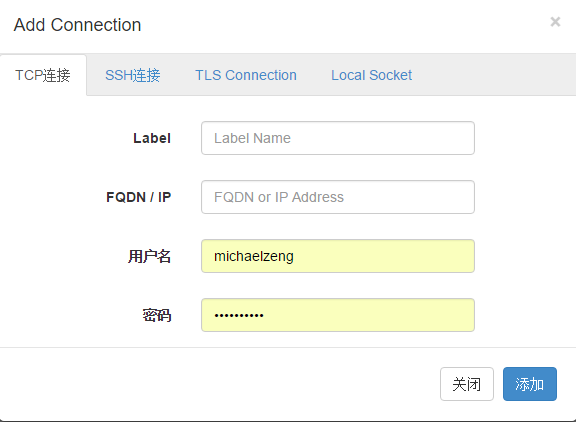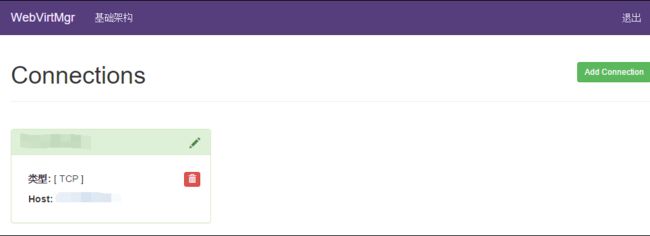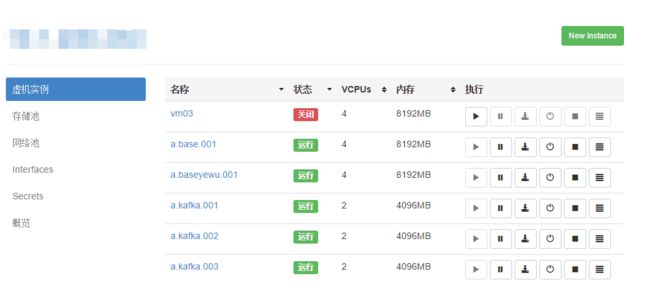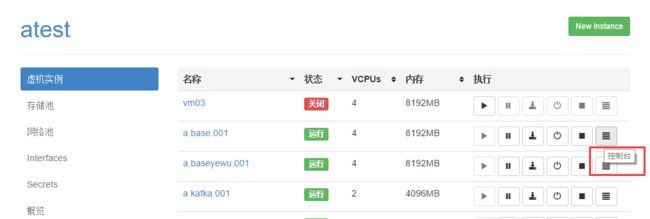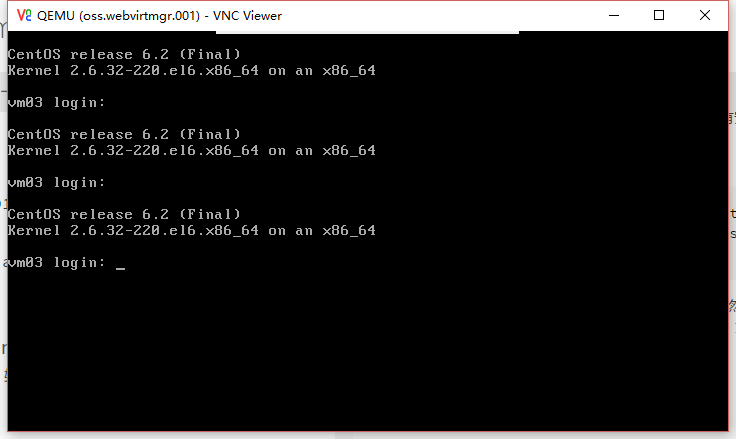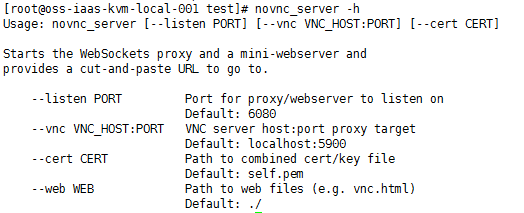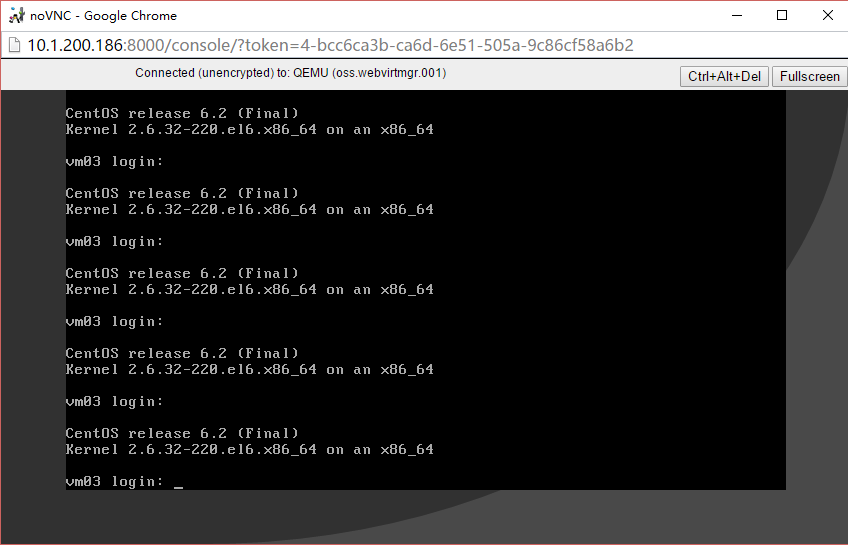知道大家部署可视化的kvm管理平台webvirtmgr不容易,这不,给大家带干活来啦~~~
前景概要:
webvirtmgr 开源框架:Git地址:https://github.com/retspen/webvirtmgr
环境:
system:centos6.8
libvirt: 0.10.2
webvirtmgr的安装,参考:https://github.com/retspen/webvirtmgr/wiki/Install-WebVirtMgr
1.安装虚拟化环境(KVM环境)
1. yum -y groupinstall 'Virtualization Tools'
2. yum -y groupinstall 'Virtualization'
3. yum -y groupinstall 'Virtulization Client'
4. yum -y groupinstall 'Virtulization Platform'
开始部署
2.安装依赖包
$ sudo yum -y install http://dl.fedoraproject.org/pub/epel/6/i386/epel-release-6-8.noarch.rpm
安装epel依赖包建议查看一下 centos6 安装 ./epel 笔记$ sudo yum -y install git python-pip libvirt-python libxml2-python python-websockify supervisor ngin
3.克隆github代码
cd /usr/local/src/
git clone git://github.com/retspen/webvirtmgr.git
4.安装webvirtmgr
cd webvirtmgr/
pip install -r requirements.txt
5 安装数据库
yum install -y python-sqlite2
6 对django进行环境配置
./manage.py syncdb
You just installed Django's auth system, which means you don't have any superusers defined.
Would you like to create one now? (yes/no): yes
Username (leave blank to use 'root'): admin
Email address: [email protected]
Password:*********
Password (again):*********
./manage.py collectstatic #生成配置文件
./manage.py createsuperuser #添加管理员账号
7 拷贝web到 相关目录
cd ..
mkdir -pv /var/www
cp -Rv webvirtmgr /var/www/webvirtmgr
8 设置ssh
ssh-keygen
ssh-copy-id 192.168.1.50
ssh 192.168.1.50 -L localhost:8000:localhost:8000 -L localhost:6080:localhost:6080
9 编辑nginx配置文件
vim /etc/nginx/conf.d/webvirtmgr.conf (新文件)添加下面内容到文件中
server {
listen 80 default_server;
server_name $hostname;
#access_log /var/log/nginx/webvirtmgr_access_log;
location /static/ {
root /var/www/webvirtmgr/webvirtmgr; # or /srv instead of /var
expires max;
}
location / {
proxy_pass http://127.0.0.1:8000;
proxy_set_header X-Real-IP $remote_addr;
proxy_set_header X-Forwarded-for $proxy_add_x_forwarded_for;
proxy_set_header Host $host:$server_port;
proxy_set_header X-Forwarded-Proto $remote_addr;
proxy_connect_timeout 600;
proxy_read_timeout 600;
proxy_send_timeout 600;
client_max_body_size 1024M; # Set higher depending on your needs
}
}
保存文件
mv /etc/nginx/conf.d/default.conf /etc/nginx/conf.d/default.conf.bak
10 启动nginx
/etc/init.d/nginx restart
11 修改防火墙规则
/usr/sbin/setsebool httpd_can_network_connect true
12 设置 supervisor
chown -R nginx:nginx /var/www/webvirtmgr
vim /etc/supervisord.conf #在文件末尾添加
[program:webvirtmgr]
command=/usr/bin/python /var/www/webvirtmgr/manage.py run_gunicorn -c /var/www/webvirtmgr/conf/gunicorn.conf.py
directory=/var/www/webvirtmgr
autostart=true
autorestart=true
logfile=/var/log/supervisor/webvirtmgr.log
log_stderr=true
user=nginx
[program:webvirtmgr-console]
command=/usr/bin/python /var/www/webvirtmgr/console/webvirtmgr-console
directory=/var/www/webvirtmgr
autostart=true
autorestart=true
stdout_logfile=/var/log/supervisor/webvirtmgr-console.log
redirect_stderr=true
user=nginx
修改/var/www/webvirtmgr/conf/gunicorn.conf.py
bind = "0:8000"
13 设置开机启动
chkconfig supervisord on
vim /etc/rc.local
/usr/sbin/setsebool httpd_can_network_connect true
14 启动进程
/etc/init.d/supervisord restart
15查看进程
netstat -lnpt 即可以看到6080和8000已经启动
16.启动Django服务
./manage.py runserver 0.0.0.0:8000
访问:http://x.x.x.x:8000(x.x.x.x - your server IP address ),输入创建的django用户和密码,如果没有创建,请用python manager.py createsuperuser,命令创建。登录后如下图所示
webvirtmgr客户端就这样搭建完了,接下来需要配置虚拟机所在宿主机的,参考git地址.
配置宿主机
配置宿主机环境:
system: centos 6.8
libvirt: 0.10.2
17.下载并执行脚本:libvirt-bootstrap.sh
如果虚拟机比较多,该脚本执行时间会比较长,因为会执行service libvirt-guests restart,会将所有运行的虚拟机挂起然后再恢复,感觉这一步不是必须的,因为我有一台只设置ssh认证,也可以正常连接。
一步不是必须的,因为我有一台只设置ssh认证,也可以正常连接。
curlhttp://retspen.github.io/libvirt-bootstrap.sh | sudo sh
18.设置防火墙:
sudo iptables -I INPUT -m state --state NEW -m tcp -p tcp --dport 16509 -j ACCEPT
19.设置TCP认证Setup TCP authorization
参考:https://github.com/retspen/webvirtmgr/wiki/Setup-TCP-authorization,webvirtmgr新建服务器连接时需要此账号
$ sudo saslpasswd2 -a libvirt demo
Password: xxxxxxAgain (for verification): xxxxxx
查看新加的账号
$ sudo sasldblistusers2 -f /etc/libvirt/passwd.db
[email protected]: userPassword
删除新加的账号:
sudo saslpasswd2 -a libvirt -d demo
验证新加的账号:
$virsh -c qemu+tcp://IP_address/system nodeinfo (virsh -c qemu+tcp://192.168.1.50/system nodeinfo)
Please enter your authentication name: [email protected]
Please enter your password: xxxxxx
CPU model: x86_64
CPU(s): 2
CPU frequency: 2611 MHz
CPU socket(s): 1
Core(s) per socket: 2
Thread(s) per core: 1
NUMA cell(s): 1
Memory size: 2019260 kB
注意:账号全名带hostname,如[email protected]
20.设置ssh认证
ssh和tcp设置一种即可,其实就是设置无密码登录,要注意的是从webvirtmgr的什么用户到宿主机的什么用户的无密码登录,比如我用root跑的django webvirtmgr,而宿主机也是root跑的virsh,所以需要设置root到root的无密码登录。而git官网推荐的是用nginx用户跑django webvirtmgr,webvirtmgr用户跑的virsh,所以设置的是nginx用户到宿主机webvirtmgr用户的无密码登录。
参考:https://github.com/retspen/webvirtmgr/wiki/Setup-SSH-Authorizatio
21.使用tcp认证连接服务器
访问:http://xxxx:8000,xxxx是webvirtmgr的ip地址,点击new connection
使用TCP连接,label填写ip地址,FQDN/IP 填写ip地址,用户名填写第三步设置tcp认证所增加的账号,这里的用户名不用加@hostname,点击添加完成。如下图:
KVM管理平台webvirtmgr部署成功!!!!
结尾附带一些配置的时候出现的常见错误,给大家参考参考吧:
1.使用ssh认证连接服务器
访问访问:http://xxxx:8000,xxxx是webvirtmgr的ip地址,点击new connection,使用ssh认证涉及到一个问题,比如我用账号webvirtmgr登录了宿主机,但是使用命令virsh list的时候,并不能列出虚拟机信息,只有root用户使用virsh list时才能查看信息。于是我设置了nginx到宿主机root的ssh认证,但是在使用webvirtmgr网页登录时,发现并不能登录,需要手动输入,而且手动输入后发现,是可用的。
后来找到原因了,因为我用root跑的webvirtmgr,所以需要设置webvirtmgr服务器的root用户宿主机的root用户的无密码登录,设置后,可以使用。
2.虚拟机控制台使用
点击虚机实例,每台虚机最后的按钮”控制台”,点击后发现报错,如下图所示
查看django后台的错误为:
ERROR:django.request:Internal Server Error: /console/
Traceback (most recent call last):
File “/usr/lib/python2.6/site-packages/django/core/handlers/base.py”, line 113, in get_response
response = callback(request, *callback_args, **callback_kwargs)
File “/data/apps/webvirtmgr/console/views.py”, line 58, in console
response.set_cookie(‘token’, token)
AttributeError: ‘str’ object has no attribute ‘set_cookie’
查找其源代码,发现可能的错误是由于虚机没有安装vnc等图形管理工具,于是在虚机的xml配置文件添加如下配置:
virsh edit oss.webvirtmgr.001
再重启虚机,如果还是不行,就先undefine,然后重新根据xml配置create试试。下载个VNC-Viewer,输入IP:5910,看能否访问,如下图所示:说明设置VNC是成功
但是从网页点击控制台按钮,发现还是不行,报错是server disconnected
访问时django后台只有如下信息:
[26/Apr/2016 05:59:56] “GET /console/?token=4-bcc6ca3b-ca6d-6e51-505a-9c86cf58a6b2 HTTP/1.1” 200 7270
参考这篇:http://ju.outofmemory.cn/entry/145497
安装了novnc,仍然报同样的错,百度谷歌也找不到相应的信息。yum -y install novnc后,无意间在服务器上发现了这个命令novnc-server
于是敲了如下命令:novnc_server –vnc IPADDR:5920,其中IPADDR为宿主机ip地址,5920是定义的虚拟机的vnc端口号。
[root@oss-webvirtmgr-001 ~]# novnc_server –vnc 192.168.1.3:5900 Warning: could not find self.pem
Starting webserver and WebSockets proxy on port 6080
WebSocket server settings:
- Listen on :6080
- Flash security policy server
- Web server. Web root: /usr/share/novnc
- No SSL/TLS support (no cert file)
- proxying from :6080 to 192.168.1.3:5900
Navigate to this URL:
http://oss-webvirtmgr-001:6080/vnc.html?host=oss-webvirtmgr-001&port=6080
Press Ctrl-C to exit
1: 10.1.196.211: Plain non-SSL (ws://) WebSocket connection
1: 10.1.196.211: Version hybi-13, base64: ‘False’
1: connecting to: 192.168.200.230:5920
结果居然ok了,console控制台起来了
这些博主真的给了我莫大的帮助,感谢他们的经验分享,如有冒犯,多多担待~>-<

